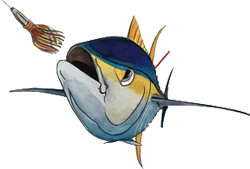
- Home
- Program Overview
- Project Descriptions
- Biology
- Oceanography
- Statistics & Modeling
- Genetics
- Economics
- Socio-Cultural
- Protected Species
- Trophodynamics
- Publications
- Meeting Documents
- Other
Fishery
Web Sites - Information for PIs
- Contact PFRP
PFRP Economics Projects
The Role of Social Networks on Fishermen Economic Performance in Hawaii's Longline Fishery
Progress Reports: FY 2012, FY 2011
Project Summary
This proposal seeks to examine the role of Social Network Capital on vessel economic performance in the Hawaii Longline Fishery (HLF). With an ethnically fragmented participation structure, the HLF offers an interesting case to examine Social Network Capital effects. Our research framework combines two methodological tools: Social Network Analysis (SNA) and stochastic production frontier analysis. We intend to collect detailed information on social linkages in the HLF and perform a SNA on the HLF. After constructing appropriate sociometric measures of Social Network Capital, we will then estimate its economic returns for longliners. More specifically, the proposal will:
1) Perform a Social Network Analysis of the HLF
- a. Map out the entire social network structure of the HLF
- b. Describe the mechanisms and processes which lead to development of social networks within the longline fleet
- c. Calculate measures for Social Network Capital based upon individual levels of social connectedness and Ethnic-Social-Capital (aggregate measures of social capital) across groups
- d. Explore linkages to policy implications (e.g. implementation of bigeye catch shares program) and operational management (e.g. bycatch reduction strategies and transshipment)
2) Estimate the return to Social Network Capital on vessel economic performance
- a. Develop a production model for the HLF that incorporates Social Network Capital as an additional input/vessel characteristic that influences technical and profit efficiency
- b. Employing stochastic production frontier models, and other efficiency analysis tools to econometrically evaluate how Social Network Capital relates to economic performance, i.e. profitability, technical efficiency and productivity
- c. Investigate the role of group (Ethnic) Social Capital on economic performance
- d. Explore the structural linkages between social networks and information sharing for future research endeavors
This proposal is in tune with the priority setting of the PFRP under the applied economics theme. Its proposed work extends previous PFRP projects and will have synergistic linkages to ongoing/future projects within PFRP. The information generated will be informative to the planning of regulatory programs for the HLF fishery management.
Expected Outcomes
Outcome 1: Social Network Analysis of the HLF. The assembly of a social network database will serve as a valuable tool for not only this research, but will contribute useful understanding to the flow of fishing operations (communication sharing, transshipments of catch, turtle bycatch reduction strategies) and provide insight to implementing regulatory shifts such as the ongoing discussions of a pelagic catch shares program. Successful adoption of catch shares will require commitment and agreement among all fishermen groups. Knowledge of HLF’s social networks structure could dramatically improve the design and execution of such a shift in management policy.
Outcome 2: An academic study estimating the returns of Social Network Capital on individual vessel technical/profit efficiency. This will be the first study to look at the economic returns to Social Network Capital in the fishery literature. The HLF provides an interesting case that is worthy of scholarly attention. We intend to produce estimates of the returns to Social Network Capital and explore the structural linkages between social networks and information sharing. We plan to publish our findings in peer-reviewed journals advancing the research in this area, and as a technical bulletin for dissemination beyond the academic community.
Outcome 3: A platform to launch future research in social networks and informational flows. We envision this project as an initiative that intends to lead to future work in this area. A future agenda is to explore the structural mechanisms of how social networks influence economic outcomes. Central to this research theme is the linking of informational flows to individual decision making via social networks. Recent works by Conley & Udry (2010) and Van den Broeck & Dercon (2010) studying the adoption of technology in developing community agriculture production, provide nice empirical examples demonstrating this linkage that manifest itself through social learning and informational upgrading responses of individual actors. Due to enormous socio-economic data demands, empirically showing this kind of direct connection is often infeasible, but the results of this project's efforts will lay the necessary groundwork to engaging in this research agenda. Such work would expand upon Curtis & McConnell’s (2004) previous examination of information sharing in the HLF. While their study found little evidence for information sharing in their analysis of HLF spatial decisions, their analysis did not incorporate the role of social networks and private sharing of information. Incorporating discriminatory sharing of information of spatial decisions via social networks would be a valuable contribution to the field. Further testable information sharing mechanisms includes linking social networks with decision-making patterns for turtle bycatch reduction strategies, transshipments patterns between vessel boats, and diffusion of technological innovations.
Funding for this project to be available late 2010.
[ Top of the page ]
References
Broeck, K. V. and S. Dercon. 2010. "Social Interactions in Growing Bananas: Evidence from a Tanzanian Village." Journal of Development Studies, Forthcoming.
Conley, T. G. and C. R. Udry. 2010. "Learning About a New Technology: Pineapple in Ghana." American Economic Review, Forthcoming.
Principal Investigators |
|
|
Dr. PingSun Leung |
Mr. Shawn Arita |

Dr. Stewart Allen |
|
![]() Download free Adobe
Acrobat Reader to view PDF files.
Download free Adobe
Acrobat Reader to view PDF files.
[ Top of the page ]


